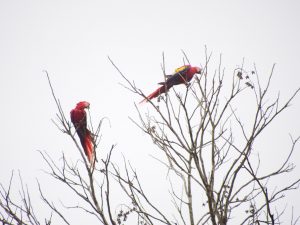
Today we spent the whole day on the pitfall trap research project. We had tied some vials of urine and water to trees and buried some in the ground to collect arthropods (briefly, bugs) and compare diversity between the canopy and the ground. We collected the tubes in the morning starting around 7am, finished an inventory by noon, and spent all afternoon until 5pm making a poster and presentation which we then presented to Amanda and Scott. We were all getting pretty tired by the end of the day, and some of us started giggling with I assume relief at the end of the presentation.
We didn’t see any new trees today, but I identified a Bay Cedar (to be fair, it is also marked with a sign along one of the trails) (Guazuma ulmifolia). I found it in a field guide using the fruit. The small, spiky fruits smell like honey and are a source of fodder for grazing animals in the dry season. However, apparently small children tend to eat them, and in large quantities they can lead to constipation, which leads to names probably coined by the parents such as stuck-up-da-butt nut or plugabutt.
We saw some more cedars this morning. They are called Spanish Cedars (Cedrela odorata), but here they are just referred to as cedars. The bark has long vertical ridges and can have darker valleys, an identification similar to that of corals (my reef taxon group!). It is easiest to identify them as large trees, and there are several such along the various trails. We have at least seen them on the “flagpole” trail to the 50-hectare plot and the Maya trail. There is also one in the clearing right in front of the cabin.
This evening we saw a lot of cool stuff. That could describe any day, but today Kaela showed me some nightjars that I identified with the help of a guidebook and Scott’s knowledge of local bird names. Apparently it was a Pauraque, which is pronounced “par-ahq.” I thought it was “pear-uh-quay” or “pear-uh-kay.” I’m learning all sorts of new things on this trip.


